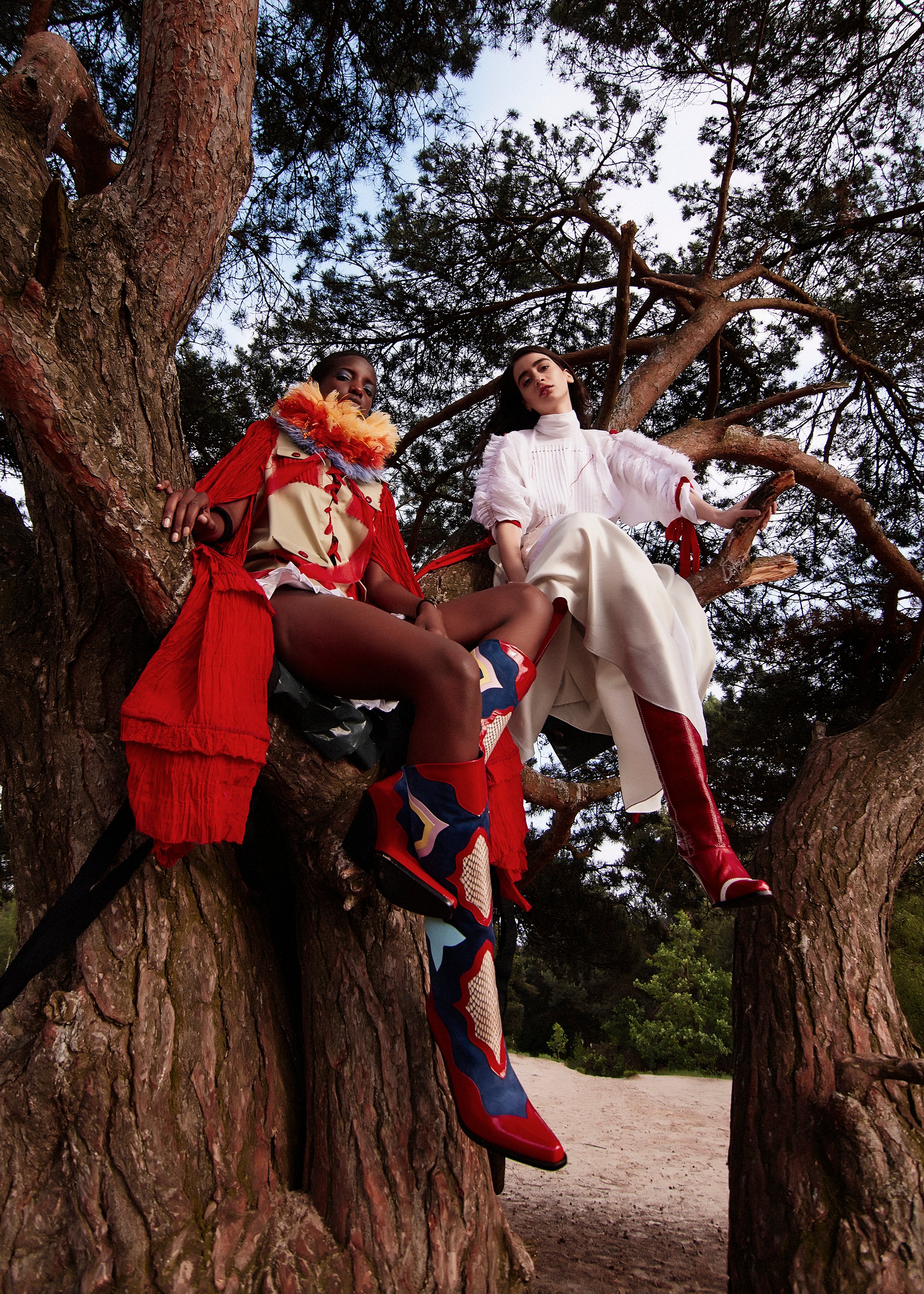SHONE PUIPIA
art4d SPOKE WITH SHONE PUIPIA ABOUT HIS RECENT COLLECTION ‘THE WILD BUNCH,’ WHERE “LINES ARE LOOSENING UP AND EDGES BROKEN DOWN.”
Could you introduce your latest collection? What is the concept behind ‘The Wild Bunch’?
Shone Puipia: The collection takes a starting point from the cult film ‘Picnic at Hanging Rock’ by Peter Weir (1975). The film tells the story of a group of Victorian schoolgirls in 1900 who went on a picnic at this enormous rock formation in Australia. Some of the more adventurous girls ventured higher up the rocks and disappeared mysteriously. It was never revealed what had happened to them.
I set about to design the collection as an alternate ending to the story, asking where they could have ended up to. Perhaps they entered into a parallel universe where that pretty and proper Victoriana character became much more wild and free. Through the clothes, we see that transformation and their journey through the rugged landscape. The pure white cottons are broken with frayed edges, wrinkled textures, rough stitches. The collection plays with contrasting materials and new expressions of animalistic and floral treatments. It is an exploration of the wilder and more sensual side of femininity.
Moving from your sketches to the physical works, it feels easy to follow how those constructed stories were imagined and then brought to life. Could you talk a bit about your process? Does the story always come first and the works respond, or is it more of a back-and-forth narration of thought?
SP: I really enjoy working on a collection that has a strong narrative behind it such as this. The visual research in the beginning is very important and that is when I bring together the different elements that build up this atmosphere for this group of girls. I make a lot of collages to create this visual universe. It also helps me figure out the direction of the collection in terms of shape, colors, and styling. For ‘The Wild Bunch,’ my design process was really intuitive. I knew from quite early on how I wanted to see the progression of the first few looks – really tell the story from one look to another. You could see that it starts out with white pieces, the first being an interpretation of the Victorian-era dress and then they gradually turn into something wild. However, after a couple of looks are done, then I would give less importance to the story but see what would complement the collection to make it coherent and whole.
You described that the collection has a sense of fragility, but that there is also a certain roughness in the way that things are put together. Could you elaborate on this looseness, it brings a sense of confidence and voice to the collection.
SP: In the beginning of the year, I really wanted to do something different than my previous collections, breaking away from familiar working patterns. You can already feel it in the drawings – I sketched more freely and intuitively. The girl is young and wild. The garments had to have that sense of spontaneity and freedom, but still be done in a very sophisticated way. Delicate fabrics were torn and left raw. Pockets were done as patches stitched on with big hand stitches. Ruffles were fabrics pulled on a ribbon that I later draped onto the body. It’s a looseness that is still grounded by attention to detail and garment finishing.
Is the collection a further collaboration with Jim Thompson Thai Silk Company?
SP: I approached Eric Booth and Jim Thompson last summer about the possibility to develop my own textiles with them for use in my MA collection. Eric was very happy to collaborate and he showed me around their mill in Pakthongchai, Nakhon Ratchasima. I was particularly interested in a technique they do called ‘warp printing,’ where the pattern is printed directly onto the yarns before they go onto the loom and are woven. It results in a beautiful ikat-like effect. The pattern becomes painterly and softened up.
We did two patterns for the collection. One was a photo collage that I made. I was thinking of a ‘surreal garden’ – taking photos of different flowers and still-life compositions of crab shells, feathers, glass shards, and others and juxtaposing them. The other pattern is a more graphic all-over floral pattern in lilac and pale yellow.
Aside from silk, it seems there is quite a combination of other unexpected sources of materials as well. Could you introduce some of the materials you’re working with?
SP: The collection plays a lot with the contrast between light and more heavy and textured materials. I start out by working a lot with light cottons and common cheesecloth. These are then worked on, whether by fraying, pleating, or wrinkling. The edges are often left raw, skirts and ribbons are literally made up of torn strips of fabrics.
I wanted to express an animalistic side and find a new way to represent fur. I developed these ‘collage fur’ textiles using needle felting done by hand, made up of yarns, feathers, and different natural fibers. The process of making these pieces was almost like painting with yarns. Other materials are eel skin and denim.
We heard that you have a show coming up this September? Any other news or upcoming events you’d like to share? What’s next?
SP: A friend from school who just finished his BA is organizing a show in Prague called “We’re Next,” showcasing 10 designers from the Royal Academy of Fine Arts Antwerp and 10 from UMPRUM Academy in Prague. I’m very excited to be a part of this and to get to show the collection again with my friends outside of Antwerp.
Right now I’m enjoying my free time and will be home during the summer. An internship with a house somewhere in Europe is an option and possible collaborations are in the planning, but that’s an announcement for later.
